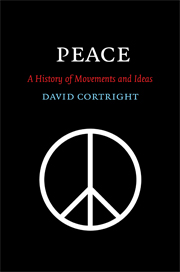2 - The first peace societies
Published online by Cambridge University Press: 05 June 2012
Summary
The aspiration for peace, the desire to create a society in which war plays little or no part, has fired human imagination throughout history. It was only at the beginning of the nineteenth century, however, that people began to form voluntary societies to educate and advocate on behalf of peace. These were educated elites who not only believed in and prayed for peace but who also engaged in organized action to formulate proposals, raise awareness, and engage with public officials. Over the centuries peace organizations have ebbed and flowed, through waves of ideological ferment and popular mobilization, in response to changing threats of war and evolving prospects for peace. This chapter traces the early history of organized peace advocacy, from its origins among religious reformers in the United States and Britain, through its spread among democratic nationalists and cosmopolitan reformers in the latter half of the nineteenth century, to its growth in many countries and emergence as a significant international presence in the years before 1914. Peace advocacy emerged from multiple and sometimes conflicting sources. Pacifist religious sects, moral revivalism, free trade liberalism, social reform movements, democratic nationalism, internationalism, even industrial philanthropy and conservative monarchy – all contributed to an ever widening if not always consistent or coherent public discourse on peace.
The expanding networks of peace advocacy began to reach significant scale by the turn of the twentieth century, with strands of influence that included even Woodrow Wilson, a member of the American Peace Society (APS) whom Jane Addams considered a fellow pacifist (in the broad sense in which the term was understood at the time).
- Type
- Chapter
- Information
- PeaceA History of Movements and Ideas, pp. 25 - 44Publisher: Cambridge University PressPrint publication year: 2008
- 1
- Cited by

